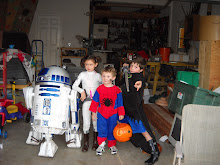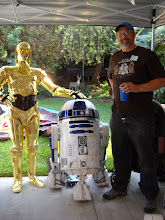The next day I went to work assembling the other drive frame. Since I had worked out all the details on the first one, this one went to together much quicker.
You can see that I've modified the sidewall on the top plate here (the whole thing is upside down) so that the bracket for the motor will sit down flush to the side plate. This helped too because I needed to move the motor in tighter to the shell to get it to fit inside a battery box. I did some work on this one, put keys into the keyways, cut chains to fit on this side and the other side, and so on. Tricky work, but rewarding. I've really enjoyed this part of the build.
So this motor went into the shell and onto the leg pretty quickly. There was a lot of trimming and adjusting of the shells to get it all to sit right, but they went in.
All that crud on the foot shell is where the weathering ran down behind the battery boxes when I painted it on. Had a brief scare when I hooked these up at first. I didn't get one of these wire nuts on tight, and I had one of the motors wired to work the other direction from the other one, so the connection between the wires in the wire nut got really hot and burned up the wire nut. I haven't seen that before. But no harm was done. I replaced the nut and wired the motor in reverse of this one and they run in tandem now. You can see how fat and tall this thing is to fit inside the battery box. Here too:
I also discovered when I got these in that they lift the R2 a bit higher than my old ones. I think my old clearance was about .5" I did that deliberately, not wanting a lot of wheel exposed. But these show quite a bit:
In fact, I had to jack up my front caster with a piece of 3/4" plywood to get it flush. That's too much I think, but fixing it will be hard. There is room in the drive frames for the wheel to run further up. That is, there's .5" of clearance or so between the top of the wheel and the bottom of the frame top plate. So the wheel could be raised in the frame effectively lowering the R2 by the same amount. That would mean cutting 4 new drive frame side plates and redrilling all the holes in them. Then I'd have to take these completely apart and reassemble them with the new side plates. But making the new plates wouldn't be too hard.
So I did quite a bit of drive testing here. The motors are a dramatic difference. First, they have amazing amounts of torque. Nothing will stop them. I even was able to just drive him up the curb--this is ill advised, but I wanted to see if he could pull the load. No problem.
That was pretty cool. And the responsiveness is just great. You touch the throttle and he goes, pull to the left or right and he turns instantly and proportionally to the stick. With the scooter motors the response was awful and I just couldn't control what he did that well. I'd have to throw the stick over all the way to get him to turn and then over compensate to straighten him out. He also stops immediately now. Chris James had commented on this with his NPC motors. When you take the power off of these, the motor stop completely with no coasting. So his stops are kind of abrupt. It can be dealt with by driving him more gently with the radio. I'll need to get used to it. He also can drive backwards with great control now and turn on a dime.
I am seeing the skittering problem in really tight turns that people had warned about. With the four wheel drive system, when you do a tight turn, one of the wheels will not be tracking or turning at the right speed because the radius of the circle it is driving isn't the same as the radius for the other wheel. So it will break loose and jump sideways a bit causing some jerking. That's annoying. Not sure what I'd do about it. One possibility would be to cut up some new side plates for a one wheel system instead of the two wheel ones, and maybe put a small caster up front for stability, and raise the wheel in the frame to lower the R2. That would take care of a couple of problems. The result would be close to a JAG system, but with chains instead of belts. BTW, these motors and the chain/gear system are much quieter than the old scooter motors. The noise isn't an issue at all. I'm very happy about that. And with the excellent level of control I've got now, I won't worry about taking him into a crowded environment.
The battery box problem is next. I think I'll try making some slightly oversized boxes to save me all the trouble of hacking and sanding and modifying my old ones or the motors. My old boxes are a bit narrow. So I got a piece of 3" PVC pipe yesterday for a measly $2.50. It's 3.5" O.D. I think I'll cut it in half down the length and then take .25" of an inch off so that the overall width of the half piece is 3.25" or so. Then I'll build the battery boxes around that. I'll post pictures when I do it. I think I'll make the boxes a little taller than called for too so that the tops of the motors clear on the inside. They will be big, but I think it won't be noticeable to anyone, probably even builders. Should take me too long to whip those up, although I will have to paint them and then get the battery harness and the braided hoses and knurled hose fittings off of my old ones and transfer them.
Here a picture of Sam (my three year old) checking out the new rig:
And finally here's some video of the new motors in action. It's pretty hard to drive with the RC radio and take the movie at the same time, and I'm not used to the motors yet, but you get the idea.




































